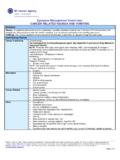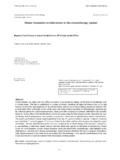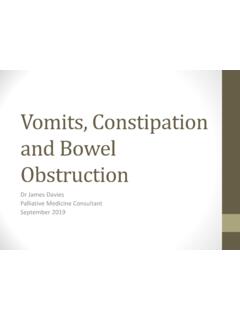Transcription of DRUG NAME: Bleomycin - BC Cancer
1 Bleomycin BC Cancer Agency Cancer Drug Manual Page 1 of 10 Bleomycin Developed: September 1994 Revised: 1 May 2007 Limited Revision: 1 March 2009, 1 June 2013, 1 December 2014 DRUG NAME: Bleomycin SYNONYM(S): NSC-125066;1 BLM ; Bleo COMMON TRADE NAME(S): BLENOXANE , generic available CLASSIFICATION: Antitumour antibiotic Special pediatric considerations are noted when applicable, otherwise adult provisions apply. MECHANISM OF ACTION: Bleomycin causes DNA strand scission through formation of an intermediate metal complex requiring a metal ion cofactor such as copper or This action results in inhibition of DNA synthesis, and to a lesser degree, in inhibition of RNA and protein The drug is cell-cycle specific for G phase, M-phase and S PHARMACOKINETICS: Interpatient variability no information found Distribution mainly in the skin, lungs, kidneys, peritoneum and lymphatics cross blood brain barrier?
2 No volume of distribution1 20 L plasma protein binding1 less than 10% Metabolism activated by microsomal reduction, degraded by hydrolase found in multiple tissues especially in liver and kidneys1 active metabolite(s) no information found inactive metabolite(s) no information found Excretion renal: 45-70% in first 24 h4 urine 60-70% active drug (less than 20% in patients with moderate renal impairment [creatinine clearance less than 35 mL/min]) feces no information found terminal half life2 2-4 h (may be prolonged with renal dysfunction); 3 h (intrapleural); 5 h (intraperitoneal) clearance2 3 L/h/m Gender no information found Elderly no information found Children5 terminal half life 3 h clearance L/h/m renal clearance 65% Ethnicity no information found Adapted from standard references3,6 unless otherwise specified. Bleomycin BC Cancer Agency Cancer Drug Manual Page 2 of 10 Bleomycin Developed: September 1994 Revised: 1 May 2007 Limited Revision: 1 March 2009, 1 June 2013, 1 December 2014 USES: Primary uses: *Cervical Cancer *Larynx and paralarynx *Lymphoma, Hodgkin s *Lymphoma, non-Hodgkin s *Malignant pleural effusion *Penile Cancer *Renal Cancer *Soft tissue sarcoma *Testicular Cancer *Vulva Cancer *Lung Cancer Other uses: Dysplastic oral leukoplakia7 Head and neck6 Kaposi s sarcoma6 Melanoma8 Mycosis fungoides8 Osteosarcoma8 Skin cancer8 Thyroid cancer8 Trophoblastic, gestational8 Cystic craniopharyngioma9 *Health Canada approved indication SPECIAL PRECAUTIONS.
3 Contraindicated in: patients who have a history of hypersensitivity reaction to Use with caution in patients3,6,8: with compromised pulmonary function, with compromised renal function, with an age greater than 40 years,10 receiving concomitant chest radiation, receiving concomitant administration of cisplatin, cyclophosphamide, methotrexate or doxorubicin, receiving positive fluid balance during prolonged surgical procedures and who smoke. These are all risk factors that can predispose the patient to Bleomycin pulmonary toxicity (BPT), which can be severe and life threatening. A cumulative dose of greater than 450 units of Bleomycin is also a known risk factor for developing BPT. Carcinogenicity: Bleomycin is carcinogenic in Mutagenicity: Bleomycin is not found to be mutagenic when using the Ames test8, but has been shown to be mutagenic in vitro and in vivo using other mutation Fertility: no information found.
4 Pregnancy: FDA Pregnancy Category D. There is positive evidence of human fetal risk, but the benefits from use in pregnant women may be acceptable despite the risk ( , if the drug is needed in a life-threatening situation or for a serious disease for which safer drugs cannot be used or are ineffective).11 Breastfeeding is not recommended due to the potential secretion into breast SIDE EFFECTS: The table includes adverse events that presented during drug treatment but may not necessarily have a causal relationship with the drug. Because clinical trials are conducted under very specific conditions, the adverse event rates observed may not reflect the rates observed in clinical practice. Adverse events are generally included if they were reported in more than 1% of patients in the product monograph or pivotal trials, and/or determined to be clinically important. ORGAN SITE SIDE EFFECT Clinically important side effects are in bold, italics allergy/immunology4 hypersensitivity reactions (fever, anaphylaxis, eosinophilic pulmonary infiltrates) blood/bone marrow anemia (mild) Bleomycin BC Cancer Agency Cancer Drug Manual Page 3 of 10 Bleomycin Developed: September 1994 Revised: 1 May 2007 Limited Revision.
5 1 March 2009, 1 June 2013, 1 December 2014 ORGAN SITE SIDE EFFECT Clinically important side effects are in bold, italics febrile neutropenia leukopenia myelosuppression (uncommon, mild) thrombocytopenia cardiovascular (general) edema of hands and feet hypotension2 myocardial infarction (rare) phlebitis (uncommon) thrombotic microangiopathy (rare) constitutional symptoms chills (common) fever (50%) less frequent with continued use8 malaise weakness, general weight loss (common) dermatology/skin extravasation hazard: rare alopecia, diffuse desquamation4 erythema facial flushing2 hyperkeratosis of hands and nails hyperpigmentation especially in creases and folds in the areas of trauma2 (frequent) hypoesthesia progressing to hyperesthesia ichthyosis, peeling and bleeding induration13 paresthesia prorates rash on pressure areas and abdominal skin creases (8%) Raynaud s phenomenon4 (rare) scaling2 stomatitis striae tenderness of skin thickening of skin2 ulcerations, tongue, lips (rare) urticaria vesiculation Bleomycin BC Cancer Agency Cancer Drug Manual Page 4 of 10 Bleomycin Developed: September 1994 Revised: 1 May 2007 Limited Revision.
6 1 March 2009, 1 June 2013, 1 December 2014 ORGAN SITE SIDE EFFECT Clinically important side effects are in bold, italics gastrointestinal emetogenic potential: Low Moderate anorexia (common) mucositis (30%) nausea stomatitis (30%) vomiting (common) hepatic hepatic toxicity (rare)8 neurology aggressive behaviour (rare) cerebrovascular accident (rare) cerebral arteritis (rare) disorientation (rare) ocular/visual periorbital edema4 pain chest pain4, acute, suggestive of pleuropericarditis (rare) myalgias2 (less frequent) pulmonary bronchospasm4 dyspnea pleuropericarditis (rare)8 pneumonitis (10%) pulmonary fibrosis (1%) rales renal/genitourinary cystitis (rare) hematuria (rare) hemorrhagic cystitis (rare) renal toxicity (rare) Adapted from standard references3,6 unless specified otherwise. Dermatologic effects are the most frequent adverse effects of Bleomycin , occurring in 50% of patients3 usually occurring 2-4 weeks after initiation of Adverse mucocutaneous effects including erythema, rash, striae, vesiculation, hyperpigmentation, and tenderness of skin usually develop in the second or third week of Bleomycin therapy.
7 Mucocutaneous effects appear to be dose related, usually occurring after 150-200 units of Bleomycin . Discontinuation of therapy due to these toxicities occurs in about 2% of Febrile reactions are seen in 50% of patients treated with Bleomycin given IV and in 25% of patients where Bleomycin is given IM. This reaction can be prevented by hydrocortisone premedication. Pre-treatment with antipyretics or antihistamines can also be used,3 but have not produced uniform results in reducing Bleomycin associated Hypersensitivity reactions occur in 1% of lymphoma patients receiving Bleomycin . This anaphylactic reaction can include hypotension, fever, chills, mental confusion, and This idiosyncratic reaction can occur immediately or be delayed for several hours. This reaction usually occurs after the first or second dose. The manufacturer Bleomycin BC Cancer Agency Cancer Drug Manual Page 5 of 10 Bleomycin Developed: September 1994 Revised: 1 May 2007 Limited Revision: 1 March 2009, 1 June 2013, 1 December 2014 suggests using a test dose of 2 units or less for the first 2 If no acute reaction occurs after 2 to 4 hours, then regular dosing may ,4 The use of a test dose is not universally Respiratory effects are the most serious side effects for Bleomycin pulmonary toxicity BPT occurs in 10% of treated In approximately 1%, the non-specific pneumonitis induced by Bleomycin progresses to pulmonary fibrosis and death.
8 Non-productive cough, dyspnea, basal rales, pleuritic chest pain and fever are frequently first signs of toxicity. Pulmonary fibrosis from Bleomycin can develop insidiously during patients should be questioned carefully for new dry unproductive cough or new respiratory limitation of exercise tolerance at each visit. Persistence of either of these symptoms for longer than one week without other explanation, such as infection, should prompt consideration of discontinuation of the Bleomycin . Some authors have recommended serial measurement of carbon monoxide diffusing capacity by pulmonary function testing, however, this has not proved to be a reliable predictor of Bleomycin toxicity and its use must be individualized. A normal chest x-ray is unreliable to exclude ,18 Identification of patients with Bleomycin induced pulmonary toxicity can be very difficult due to the non-specific signs and Treatment includes corticosteroids for pneumonitis to prevent pulmonary fibrosis and antibiotics for infectious pneumonitis.
9 See Special Precaution section for risk factors which can predispose a patient to BPT. In addition to these risk factors oxygen therapy after treatment with Bleomycin is considered a risk factor to developing BPT. The following recommendations have been developed regarding the use of oxygen therapy in patients who have been treated with bleomycin10: 1. Although the evidence is inconsistent with regards to the relationship between supplemental oxygen therapy and Bleomycin lung toxicity, patients should not be denied oxygen therapy if hypoxia is documented or anticipated. 2. If supplemental oxygen is required, the lowest FIO2 that maintains adequate tissue oxygenation (as measured by arterial blood gasses or pulse oximetry) should be provided. 3. Preoperative anaesthesia consultation should be mandatory for patients with a history of Bleomycin therapy. 4. Recreational use of high flow oxygen ( , scuba diving) should be discouraged.
10 5. patients should be encouraged to carry wallet cards or wrist bracelets alerting caregivers to possible toxicity associated with oxygen therapy. (More information under "A Guideline for Oxygen Therapy for patients who have Received Bleomycin Systemic Therapy" after References) INTERACTIONS: AGENT EFFECT MECHANISM MANAGEMENT cisplatin1 may increase risk of Bleomycin toxicity reduced Bleomycin elimination monitor for Bleomycin toxicity digoxin19 may decrease digoxin levels changes to intestinal mucosa may decrease digoxin absorption monitor for decrease in pharmacological effect of digoxin phenytoin19 may decrease phenytoin levels decreased absorption, increased metabolism of phenytoin monitor serum levels of phenytoin vincristine8 sequential administration of vincristine given before Bleomycin may improve Bleomycin efficacy vincristine arrests cells in mitosis so that they are more susceptible to the actions of Bleomycin can be used for therapeutic advantage Bleomycin BC Cancer Agency Cancer Drug Manual Page 6 of 10 Bleomycin Developed: September 1994 Revised: 1 May 2007 Limited Revision: 1 March 2009, 1 June 2013, 1 December 2014 SUPPLY AND STORAGE: Injection.

















